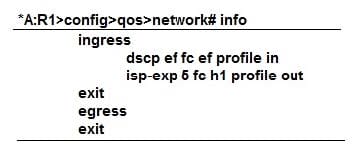Exam Details
Exam Code
:4A0-107Exam Name
:Nokia Quality of ServiceCertification
:Nokia CertificationsVendor
:NokiaTotal Questions
:212 Q&AsLast Updated
:Mar 27, 2025
Nokia Nokia Certifications 4A0-107 Questions & Answers
-
Question 41:
If packets egressing a SAP do not match any criteria defined in the SAP-egress policy, which forwarding class will these packets be assigned to?
A. The default forwarding class defined in the SAP-egress policy.
B. The forwarding class inherited from network ingress classification.
C. Best Effort.
D. If there is no match, packets will be dropped.
-
Question 42:

In the image shown above, the network QoS policy is applied properly to a Nokia 7750 SR. An MPLS packet with dot1p=1, EXP=4, and DSCP=AF is received. Which forwarding class and profile is assigned to this packet?
A. EF, in
B. H1, out
C. BE, out
D. L1, in
-
Question 43:
In a Nokia 7750 SR, which of the following QoS policies CANNOT include packet classification criteria?
A. SAP-ingress
B. SAP-egress
C. Network-queue
D. Network
-
Question 44:

In the image shown above, the SAP-ingress policy is applied properly to a Nokia 7750 SR. A packet is received from an IP address of 192.168.2.2 with DSCP set to AF. Which forwarding class and priority level is assigned to this packet?
A. NC, low
B. NC, high
C. BE, low
D. BE, high
-
Question 45:
In a Nokia 7750 SR, which of the following is a class type that is intended for non-real-time customer traffic that requires some committed bandwidth?
A. Gold
B. Assured
C. High Priority
D. Best Effort
-
Question 46:
What feature makes a traffic stream real-time?
A. Its rate fluctuates rapidly with time.
B. Its bandwidth requirements are high.
C. Time between packets remains unchanged and end-to-end delay is kept to a minimum.
D. All packets received are guaranteed to be delivered to the destination.
-
Question 47:
Why are the four QoS steps (classification, queuing, scheduling, and marking/remarking) executed twice for every packet entering a 7750 SR router?
A. Once before going through each of the redundant switching fabrics.
B. To protect against failure of either ingress or egress card.
C. Once before going through the switching fabric, and once more before going onto the egress port.
D. Once to decide if the packet is in-profile or out-of-profile, and once more to process the packet according to its profile.
-
Question 48:
Which of the following statements defines the committed information rate?
A. It is the rate at which a traffic stream is offered to a queue.
B. It is the rate at which packets are forwarded out of a queue.
C. It is the minimum rate at which packets may be forwarded out of a queue.
D. It is the maximum rate at which packets may be forwarded out of a queue.
-
Question 49:
Which of the following statements describes an advantage of the DiffServ QoS model over the IntServ QoS model?
A. DiffServ reserves resources dynamically using the RSVP protocol.
B. DiffServ only requires packets to be classified into forwarding classes at the first network hop.
C. DiffServ provides granular differentiation and superior fairness because it processes traffic streams individually.
D. DiffServ is more scalable it treats traffic streams as aggregates.
-
Question 50:
Which action does the packet remarking process perform?
A. It determines the packet's forwarding class based on classification criteria
B. It modifies the current packet's forwarding class to indicate promotion or demotion
C. It sets the TOS, DSCP, EXP, or Dot1p field based on classification criteria
D. It modifies the current TOS, DSCP, EXP, or Dot1p marking to indicate promotion or demotion
Related Exams:
4A0-100
Nokia IP Networks and Services Fundamentals4A0-101
Nokia Interior Routing Protocols4A0-102
Nokia Border Gateway Protocol for Internet Routing4A0-103
Nokia Multiprotocol Label Switching4A0-104
Nokia Services Architecture4A0-105
Nokia Virtual Private LAN Services4A0-106
Nokia Virtual Private Routed Networks4A0-107
Nokia Quality of Service4A0-108
Nokia Multicast Protocols4A0-109
Alcatel-Lucent Triple Play Services
Tips on How to Prepare for the Exams
Nowadays, the certification exams become more and more important and required by more and more enterprises when applying for a job. But how to prepare for the exam effectively? How to prepare for the exam in a short time with less efforts? How to get a ideal result and how to find the most reliable resources? Here on Vcedump.com, you will find all the answers. Vcedump.com provide not only Nokia exam questions, answers and explanations but also complete assistance on your exam preparation and certification application. If you are confused on your 4A0-107 exam preparations and Nokia certification application, do not hesitate to visit our Vcedump.com to find your solutions here.